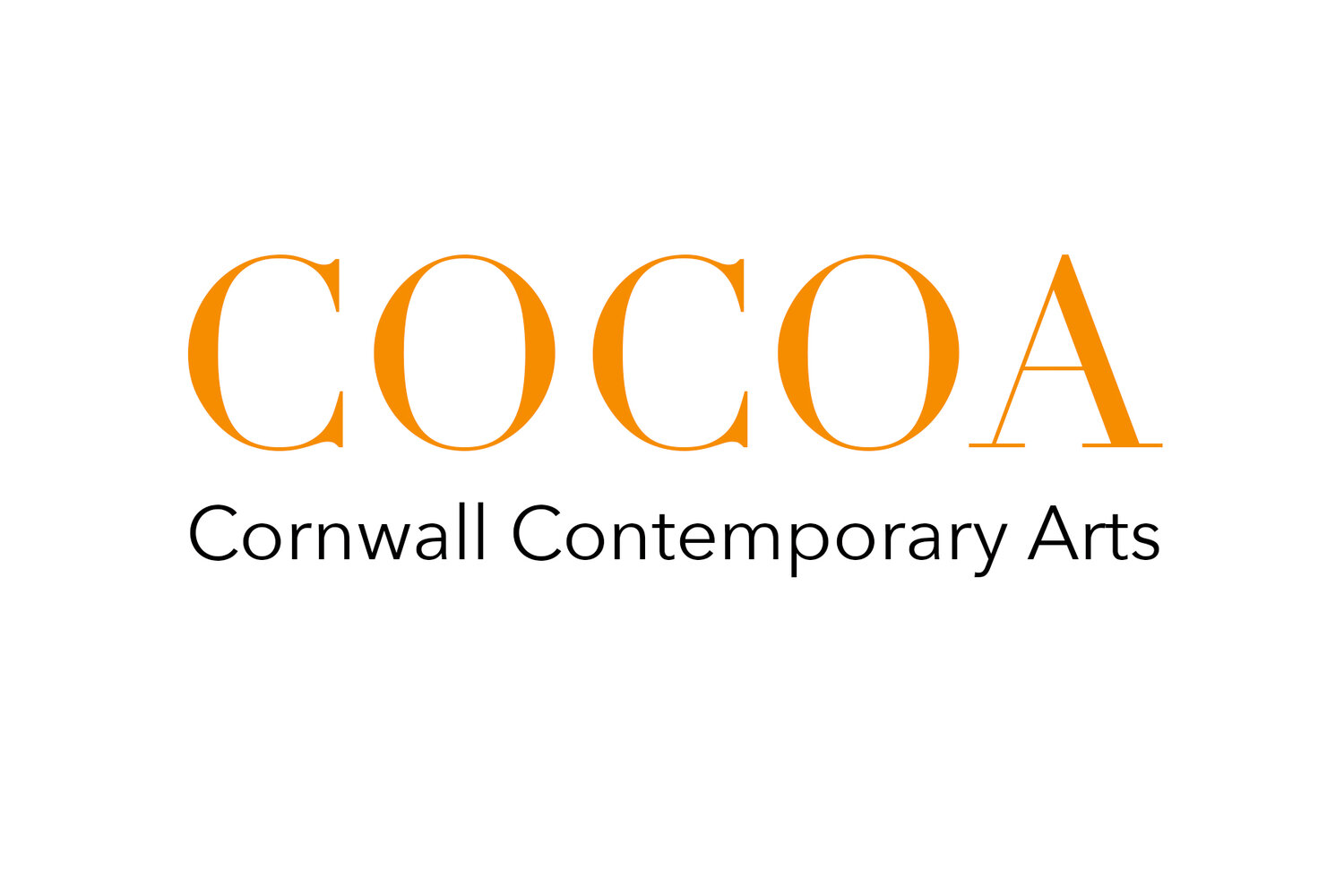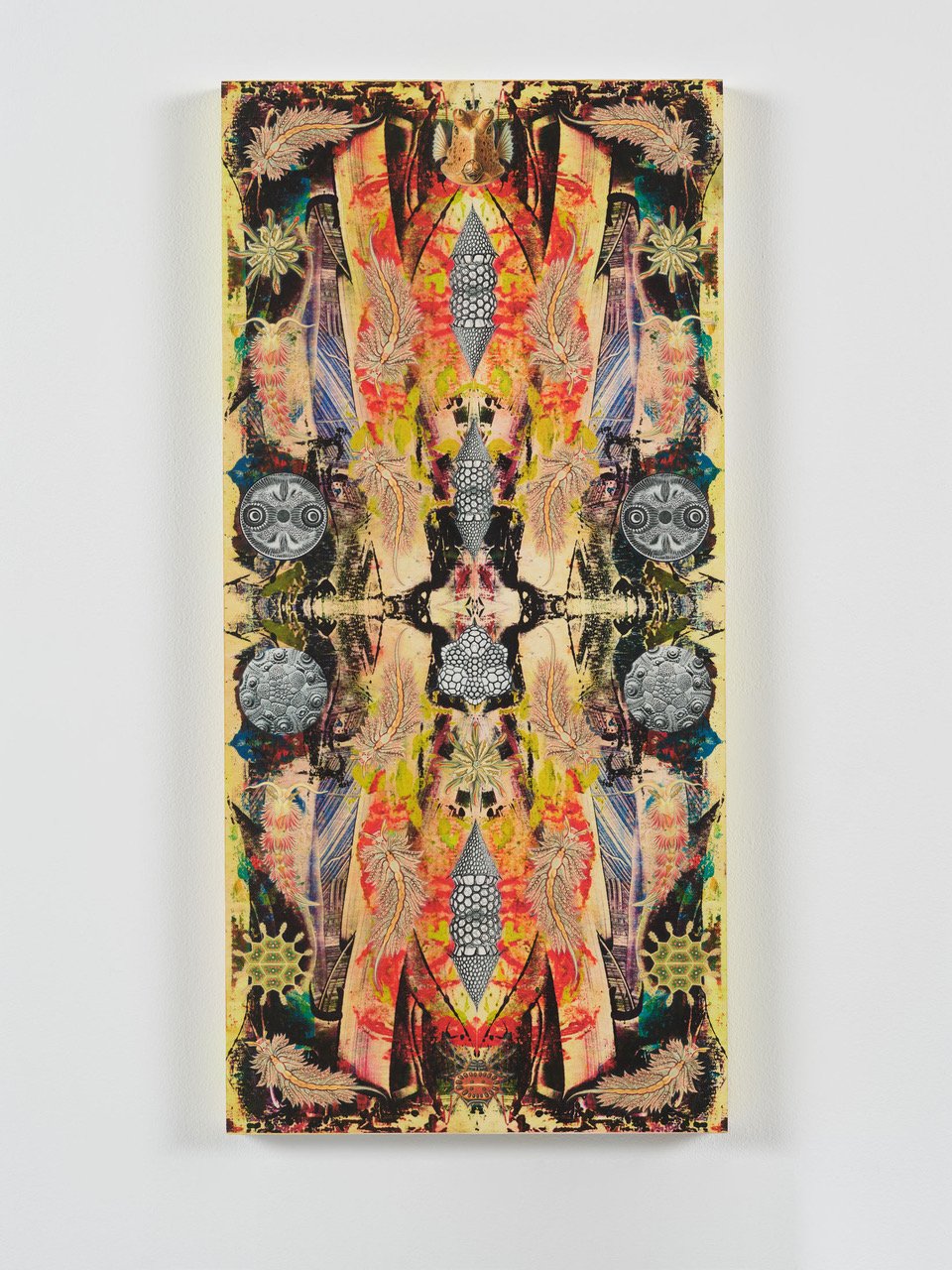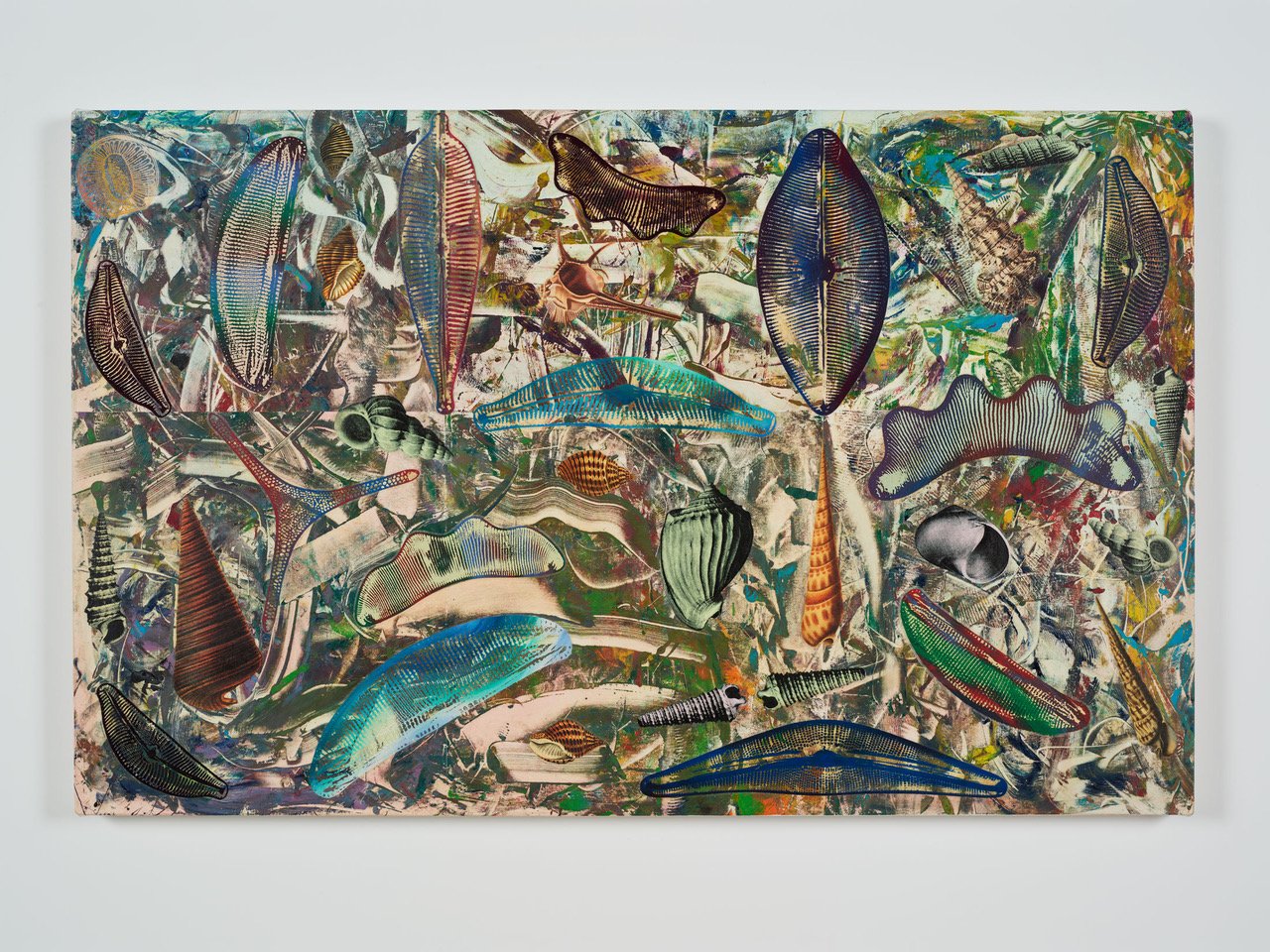SIXTY DELICATE WORKS ON PAPER: Philip Taaffe at Luhring Augustine Tribeca, November 12 —December 22, 2022
All photos are: © Philip Taaffe; Courtesy of the artist and Luhring Augustine, New York. Photos: Farzad Owrang.
Philip Taaffe, Panel with Larger Frogs, 2022, Mixed media on panel, 30 7/8 x 41 5/8 inches
For the past decade, Philip Taaffe has been showing large and larger canvasses of dazzling variety at Luhring Augustine’s several locations. In his recent exhibition at the gallery’s Tribeca space, the artist scaled down and zoomed in. Showing some sixty delicate works on paper mounted on panel, Taaffe focused on just two modi operandi from his extensive bag of tricks: natural science exotica and the play of symmetry. Most of these works bristle with vintage illustrations of mollusks, crabs, insects, spiders or other creeping, crawling fauna, but in such densely mirroring, contrapuntal arrangements as to create a kind of meta-zoology. Not only the creatures but also the swirling gestural backgrounds are printed and collaged, something of a departure from the technique of the canvases. Newer still is the particular method of printing — a potentially radical development, although so far writ small.
At the beginning of his prolific career, Taaffe captured the zeitgeist by appropriating Bridget Riley paintings, reproducing their curvy motifs with linoleum printing. The modular method, from a decorator’s toolbox, was seen at the time as part of a suave 1980s critique of 1960s Ab Ex, Color Field and, most presciently, Op. But any critique proved to be an exceedingly fond one. In the succeeding four decades Taaffe has enlisted a whole range of printing, stamping, stenciling, collaging, decalcomania and marbling techniques, all in the service of sublime optical buzz. Taaffe’s ready-to-hand efficiencies, far from being cheeky, turned out to be instinctive alchemical rituals with infinite permutations — in a word, painterly.
Philip Taaffe, Nudibranch, 2021, Mixed media on panel, 28 3/8 x 13 1/2 inches
Taaffe was in the vanguard of a generational shift; in the new zeitgeist, painting no longer had to apologize for itself — or not quite. Since storming the barricades, however, the artist has been fixated on the past, sometimes skating close to the nostalgic. If he used silkscreen it was not to repurpose pulp headlines and movie stars but rather antique lithographs and photogravures from the fatally self-assured age of Haeckel and Boas. Contemporary photographs or subject matter need not apply, never mind digital media! But look closely at the gestural background patterns beneath the collaged imagery in works in the present show such as Composition with Spiders and Wasps I and Nudibranch (all works 2022), with their vertical and horizontal mirror symmetries. You can see the seams where the folds would appear if Taaffe had composed these images in the usual ink-blot manner, as he has done to spectacular effect in the past. (The group of folded and refolded works on paper he showed at Gagosian in 2010 are the densest and most visionary — and spookiest — in his oeuvre.) What the seams imply, and the uninflected matte surface confirms, is that imagery has been copied, mirrored and printed in reciprocal halves, digital means underpinning Taaffe’s customary hand manipulations. Digital artifacts are also evident in the foreground elements, with consistent margins encircling the spiders, et al., slightly raised like decals. At a modest distance the pictorial dynamics between figure and ground are typically rich and satisfying, but at close range the lack of integration is somewhat distracting.
Philip Taaffe, Composition with Crabs, Algae and Shells, 2022, Mixed media on panel, 22 1/2 x 14 1/4 inches
Taaffe’s mastery of scissors and glue may not translate to Photoshop, but consider this thought experiment: What if Taaffe had composed and printed a seamless version of these same compositions using the Clone Stamp Tool, Layers, Undo and the rest? My guess is that the artist has good reasons not to go there. But it is hard to ignore the infinitude of non-linear possibilities that are open to him now that he has crossed the digital frontier.
I hasten to add that Taaffe’s hybrid technique has its own intrinsic prospects, which he explores with particular sensitivity in five slim, vertical works full of miniscule detail and intersecting pattern. In these bilateral slivers the artist withholds his cabinet of curiosities, allowing figurative ghosts reminiscent of the tribal masks and totems he has used elsewhere to emerge purely from the distended vertical echo. Originating in gestural monotypes, the moody soaked-in color, printed with fine dyes onto sumptuous rice paper, can whisper, as in Columnar Figure II (“Color is the Fruits”), or burn, as in Columnar Figure III (Hittite) — effects that Taaffe amplifies kaleidoscopically, mirroring not only side to side but top to bottom in locally nested segments. The effect is like magnified filigrees of microfilm or synesthetic transcriptions of music.
Philip Taaffe, Columnar Figure II ("Color is the Fruits"), 2022, Mixed media on panel, 79 x 5 1/2 inches
At the other end of the spectrum, Taaffe is showing a number of smeared, stamped and scraped monotypes, presumably part of his supply chain for digitizing, which eschew all devices of symmetry and multiplication. Here the impressed inks glisten and bulge, still viscous on the absorbent paper, while the gestures are raw and rhythmic, perhaps shamanic — 10th Street de Kooning rather than the Easthampton version. While these purposefully inelegant works are not without interest, they seem lacking in development on their own terms; we are used to Taaffe deftly covering his tracks. A couple of blotchier monotypes are transformed by silhouettes of bees into disconcertingly conventional landscape, but in Painting with Diatoms and Shells I, II and III (the only “paintings” so-designated in the exhibition), the artist extends the rawness intriguingly, embedding his fossils helter-skelter into a belligerent grid of monotypes. The result is tough and molten.
The lion’s share of the panels, though, show Taaffe at his phantasmagoric best, the raw gestures rendered architectonic by powers of reflection, then overspread with creatures of water, air and land. Beside those life forms already mentioned, we get vivid frogs in a bifurcating fen; lizards that sinuously weave upwards, Escher-like; elongated fish standing in for hovering paint strokes; and flamboyant birds from birding guides, perhaps a nod to Fred Tomaselli’s centripetal Bird Blast, but here exotically quadrilateral in the manner of a Persian carpet, the prevailing compositional theme throughout. Crabs and spiders with their quasi-radial symmetries, and algae and seaweed with their fractal implications, help stir this boiling pot of graphic potential. Though built out of compound symmetries, each of these distinct variations pulses with organic surprise and dissonance, and each gives its own account of a luminous, translucent palette seemingly derived from gems, crushed ivy and old wine.
Philip Taaffe, Painting with Diatoms and Shells II, 2022, Mixed media on canvas, 24 1/2 x 39 inches
When I interviewed Taaffe in 2001 for an article about Art Forms in Nature — evolutionary biologist Ernst Haeckel’s trippy, almost too powerfully rendered 1904 compendium of the microbial baroque — the artist explained how he began using natural science imagery as a kind of “paintbrush” leading to “gestural conjunctions.” Snakes, with their built-in undulations, were among the first such screenprinted invaders of Taaffe’s crisply stenciled oeuvre, which by then was centered less on the history of abstraction than on the mystical grammar of world ornament. But while Taaffe’s antiquarian library has since burgeoned, reports of mass die-offs among butterflies, bees, spiders, amphibians and all the rest have become sadly familiar. Surely the profusion of amazing creatures in the current show, while still working magnificently as “gestural conjunctions,” is also meant as a symphony of lament, a cosmic elegy — not only for vanishing species but for a civilization of classification and knowledge, conquest and hubris. If Taaffe’s recent experiments with computers seem at odds with his devotion to the manual arts and the cult of the book, Original Sin is equally implicated in either way of working. What else is the meaning of the bitten Apple?
Philip Taaffe, Siren, 2022, Mixed media on panel, 17 3/8 x 14 7/8 inches







